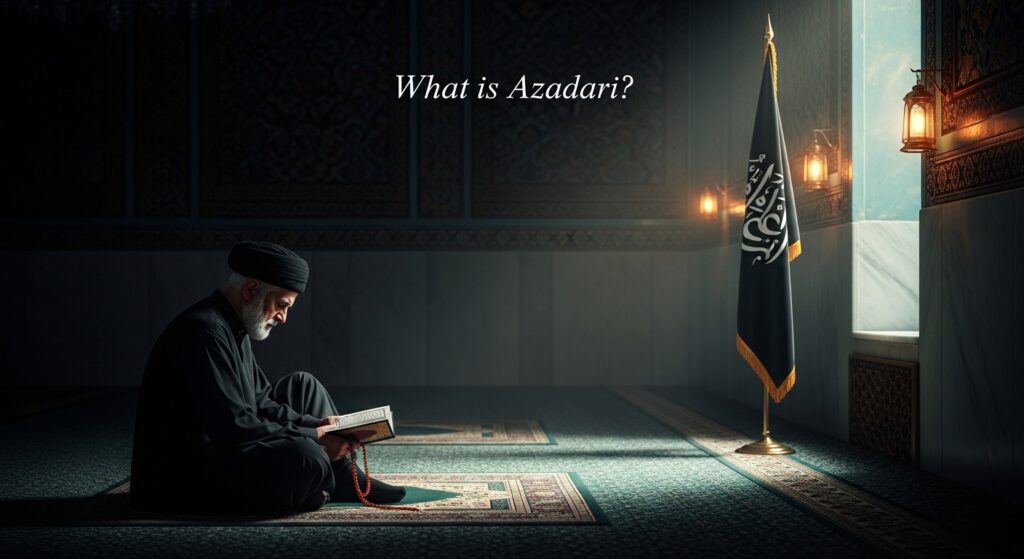Table of Contents
- Introduction
- Historical Background
- The Sacred 10 Days of Muharram
- Teachings and Lessons of Azadari
- Ziarat and Spiritual Significance
- Influence on Today’s World
- Conclusion
- FAQs
- Glossary
Introduction
Every year, as the crescent moon of Muharram appears in the sky, a wave of sorrow sweeps across the hearts of millions. Streets are draped in black, homes echo with poetry, and the air fills with the soft rhythm of matam (chest beating). This is Azadari — the sacred mourning and remembrance of Imam Hussain (a.s), the grandson of the Prophet Muhammad (s.a.w), who made the ultimate sacrifice in the desert of Karbala.
But what is Azadari, really? It’s more than mourning — it’s a spiritual uprising, a journey of love, pain, and loyalty. Through majlis, nohas, ziarat, and processions, Azadari serves as a bridge connecting the believer to the soul-stirring tragedy of Karbala.
Historical Background
The foundation of Azadari was laid in the year 61 AH, when Imam Hussain (a.s) and his 72 companions were martyred by the tyrant Yazid’s army. This event was not merely a battle; it was the defining struggle between truth and falsehood, between honor and humiliation.
After the battle of Karbala, it was the women and children — especially Lady Zainab (s.a) — who preserved this history by narrating the events. Through speeches in Kufa and Damascus, they initiated the first forms of Azadari, spreading awareness of the unjust killing of the Prophet’s family.
Over time, Azadari became formalized with:
- Majlis: Religious gatherings
- Marsiya and Noha: Lamenting poetry
- Ziarat: Visitation or recitation in honor of the martyrs
- Alam and Processions: Symbols of the banners of Abbas (a.s)
These rituals have preserved the message of Karbala for over 1,300 years.
The Sacred 10 Days of Muharram
The first 10 days of Muharram are the most spiritually intense days in the Islamic calendar. Each day is a chapter in the Karbala narrative, building up to the ultimate sacrifice on Ashura (10th Muharram).
Here is a breakdown of these powerful days:
1st Muharram
The arrival of the sacred month. The family of Hussain (a.s) enters Karbala and sets camp.
2nd to 6th Muharram
Daily Majalis begin across the world. Poets and scholars recall the arrival of Yazid’s army and the growing tension.
7th Muharram
Water is blocked from the family of Hussain (a.s) — a tragic turning point. The thirst begins.
🔗 Related: The Hands of Hazrat Abbas (a.s): Symbols of Honor and Sacrifice
8th Muharram
Dedicated to Hazrat Abbas (a.s) — the standard-bearer who gave his life trying to fetch water for the children.
9th Muharram – Shab-e-Ashur
A night of sorrow, prayer, and farewell. The family prepares for martyrdom. Imam Hussain (a.s) spends the night in worship.
10th Muharram – Ashura
The day of supreme sacrifice. One by one, the companions and family members of Imam Hussain (a.s) are martyred. The Imam himself is killed on the burning sands. His head is severed and raised.
Azadari on Ashura is observed with:
- Mourning processions
- Majlis and matam
- Recitations of Ziarat Ashura
- Reenactments (Tazia) in some regions
“Every tear for Hussain is a pearl of salvation.” – Imam Ja’far al-Sadiq (a.s)
Teachings and Lessons of Azadari
Azadari is more than tears; it is education, transformation, and revolution. Each ritual contains layers of moral and spiritual guidance:
✦ Resistance Against Injustice
Imam Hussain (a.s) taught: “A person like me will never pledge allegiance to a tyrant like Yazid.” Azadari keeps this message alive.
✦ Courage and Patience
Even as Ali Akbar (a.s) fell in battle and Sakina (s.a) wept for water, the camp of Imam Hussain (a.s) showed patience that inspires today’s believers.
✦ Dignity in Adversity
Lady Zainab (s.a) showed that modesty and eloquence can defeat oppression in its most brutal form.
✦ Justice, Loyalty, and Brotherhood
Each companion gave their life for values we often forget in daily life. Azadari helps us recenter our spiritual priorities.
Ziarat and Spiritual Significance
Ziarat, both physical and verbal, is a core aspect of Azadari. Pilgrims travel to Karbala, Najaf, and other sacred shrines, seeking spiritual purification.
For those unable to travel, reciting Ziarat Ashura or Ziarat al-Warith brings immense reward. These ziyarat texts act as both salams (greetings) and pledges of loyalty to Imam Hussain (a.s).
Ziarat gives:
- Spiritual strength to face life’s challenges
- A direct connection to the martyrs of Karbala
- A sense of belonging to the Ummah of Hussain (a.s)
Influence on Today’s World
Azadari has grown into a global spiritual movement. From mosques in Pakistan to processions in Toronto, the message of Karbala unites millions.
✦ Modern Expressions
- Livestreamed majlis on YouTube
- Noha albums and Islamic poetry shared online
- Charity drives in Muharram to honor Imam’s legacy
✦ Humanitarian Inspiration
During Azadari, communities serve food (nazar), distribute water (sabeel), and offer free medical camps — all in remembrance of the thirst and suffering of Karbala.
Conclusion
Azadari is not a ritual of the past — it is the soul’s protest against every form of injustice today. As we mourn for Imam Hussain (a.s), we awaken our own conscience.
Let us not merely listen to majlis — let us live like Hussain (a.s). Let’s be truthful like Qasim (a.s), loyal like Abbas (a.s), patient like Zainab (s.a), and compassionate like Hussain (a.s).
🌹 Keep the message of Karbala alive. Share it. Live it. Be transformed by it.
FAQs
1. What is the meaning of Azadari in Islam?
Azadari is the mourning and remembrance of Imam Hussain (a.s) and his sacrifice in Karbala. It includes majlis, noha, ziarat, and processions.
2. Why is Azadari especially important during Muharram?
Muharram marks the anniversary of Karbala. The first 10 days, especially Ashura, are sacred days of reflection and grief.
3. Can children participate in Azadari?
Yes. Children are encouraged to learn the story of Karbala, participate in nohas, and attend majalis to grow spiritually.
4. What is Ziarat Ashura?
It is a devotional recitation that honors the martyrs of Karbala and expresses disassociation from their killers.
5. Is Azadari only a Shia practice?
While deeply rooted in Shia Islam, the message of Karbala resonates with all who value justice, truth, and human dignity.

